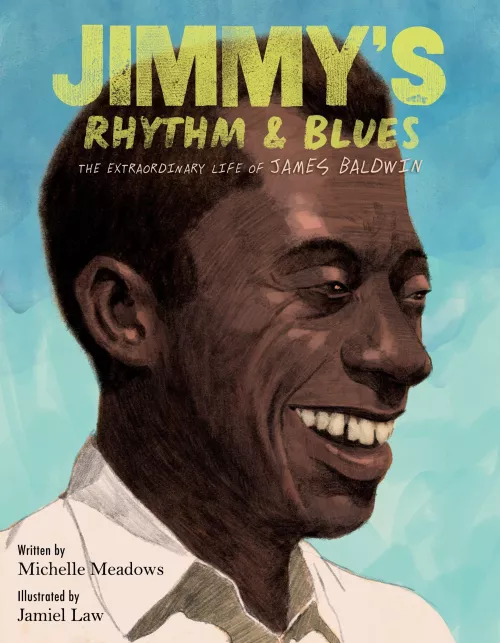Share this book
In Jimmy’s Rhythm & Blues, author Michelle Meadows uses the language of color to describe emotions, places, and objects in Jimmy’s surroundings. For Jimmy, “outside is cement gray,” “writing is electric blue,” and “jazz is passion purple.” Ask students to share how they connect with colors. How does color relate to their other senses? Talk about how colors can be used to represent feelings, places, activities, and even people. Ask students to think about what they associate with specific colors and why.
Then, have students return to the book and review the poetic language the author uses to show how Jimmy might have felt about places and things that were important to him (as in “Writing is electric blue, bright, brilliant swirls of letters and words flying, flipping, flowing to the beat.”). Ask them to develop colorful descriptions of their own about people or places they value or their passions or interests. Have them follow the format used in the book and provide markers or paints for students to add additional color to their verse. Have students choose one description to share with the class and to explain what the symbolism behind the color is for them. Students can further see whether their classmates have similar or different associations with specific colors when you display their work on a bulletin board.
Questions for Discussion or Reflective Writing
- Had you heard of James Baldwin before reading this book? Why is it important to learn about James Baldwin as both an author and an activist? How were you able to make a connection with Jimmy and his life story?
- How do you think Jimmy’s background and upbringing have influenced his ideals later in life? How did Jimmy bring about positive change and influence how others saw the world?
- Why do you think the author gave the book the title Jimmy’s Rhythm and Blues? What role does music play in Jimmy’s life? What are some other ways to interpret the words “rhythm” and “blues?”
- Who inspired Jimmy to pursue his talents? Who in your life encourages you to follow your interests and dreams?
- What did you learn about race and identity from Jimmy’s experiences and actions?
- What details make this book a real story rather than just a summary of James Baldwin’s life?
Related Resources
Introducing an Icon from Teaching Social Justice with Children's Books
Color, Symbol, Image Teaching Strategy from Facing History & Ourselves
Six Tips for Explaining Colors to a Blind Child from National Braille Press
More Titles to Try
-
There Was a Party for Langston
by Jason Reynolds; illustrated by Jerome Pumphrey and Jarrett Pumphrey
-
Poet: The Remarkable Story of George Moses Horton
by Don Tate
-
Just Jerry: How Drawing Shaped My Life: A Memoir written and illustrated by Jerry Pinkney
by Jerry Pinkney
-
Ellington Was Not a Street
by Ntozake Shange; illustrated by Kadir Nelson
-
Jump at the Sun: The True Life Tale of Unstoppable Storycatcher Zora Neale Hurston
by Alicia D. Williams; illustrated by Jacqueline Alcántara
-
It Jes’ Happened: When Bill Traylor Started to Draw
by Don Tate; illustrated by R. Gregory Christie
Stay on top of current education news



